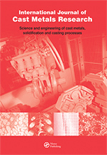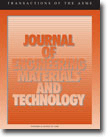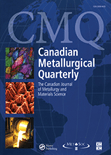
Metals
Scope & Guideline
Empowering the scientific community with open access to metallurgical advancements.
Introduction
Aims and Scopes
- Materials Science and Engineering:
Research on the microstructural behavior of metals, including the effects of alloying elements, phase transformations, and mechanical properties under different processing conditions. - Corrosion and Surface Engineering:
Studies focused on understanding corrosion mechanisms, protective coatings, and surface treatments to enhance the durability and performance of metallic components. - Additive Manufacturing and Advanced Processing Techniques:
Exploration of novel manufacturing methods such as laser powder bed fusion, wire arc additive manufacturing, and their impact on the properties of metals. - Mechanical Properties and Failure Analysis:
Investigations into the mechanical behavior of metals under various loading conditions, including fatigue, fracture mechanics, and the influence of microstructure on performance. - Recycling and Sustainable Processing:
Research aimed at improving the recycling processes for metals, including hydrometallurgical and pyrometallurgical methods, to promote sustainability in the metallurgical industry. - Computational Modeling and Simulation:
Application of computational methods and machine learning techniques to predict material behavior, optimize processing parameters, and analyze complex interactions in metallic systems.
Trending and Emerging
- High-Entropy Alloys:
Research on high-entropy alloys is gaining momentum due to their unique properties and potential applications in various industries, including aerospace and automotive. - Nanostructured Materials:
There is an increasing focus on nanostructured materials and their properties, particularly in applications involving improved mechanical performance and corrosion resistance. - Biocompatible Metals and Alloys:
Studies on biocompatible metallic materials for medical applications are trending, driven by the demand for advanced materials in healthcare, particularly in implants and prosthetics. - Machine Learning in Materials Science:
The integration of machine learning techniques in materials science is emerging as a significant trend, facilitating predictive modeling and optimization of material properties and processing methods. - Sustainability and Recycling Methods:
Research aimed at sustainable practices and recycling of metals is increasingly important, reflecting the industry's shift towards environmentally friendly processes and material recovery. - Additive Manufacturing Innovations:
Innovations in additive manufacturing techniques, including hybrid processes and new materials tailored for specific applications, are trending as industries seek more efficient production methods.
Declining or Waning
- Traditional Metallurgy:
Research focused on classical metallurgy processes has been overshadowed by more advanced studies in additive manufacturing and computational modeling, leading to a decrease in traditional techniques being published. - Basic Alloy Studies:
Basic studies on fundamental alloy systems without significant application or innovation have seen a decline, as the journal increasingly favors research with practical implications and advanced processing. - Single-Material Research:
Papers focusing solely on single-material studies without comparative analyses or multi-material approaches are becoming less prevalent, reflecting a trend towards more integrated and application-oriented research.
Similar Journals

RARE METAL MATERIALS AND ENGINEERING
Illuminating Pathways in Rare Metal ResearchRARE METAL MATERIALS AND ENGINEERING is a vital academic journal dedicated to advancing the fields of materials science, engineering, and metallurgy. Published by the NORTHWEST INST NONFERROUS METAL RESEARCH in China, this journal has been an essential resource for researchers and professionals since its inception in 1993. With a focus on rare metals and their engineering applications, the journal addresses contemporary issues and innovations in materials chemistry and electronic engineering, providing insights into the properties and uses of advanced materials. Although it currently falls within the Q4 category for several categories, including Electrical and Electronic Engineering and Materials Chemistry, its commitment to quality and relevance in the field is evident. The journal offers a platform for researchers to share their findings with the scientific community, fostering collaboration and knowledge exchange in an important area of study. Researchers and students interested in exploring the latest in rare metal technologies and engineering methodologies will find this journal a valuable addition to their academic library.

INTERNATIONAL JOURNAL OF CAST METALS RESEARCH
Unveiling Insights into the Mechanics of MaterialsInternational Journal of Cast Metals Research, published by Taylor & Francis Ltd, serves as a premier platform for the dissemination of cutting-edge research in the fields of Mechanical Engineering, Mechanics of Materials, and Metals and Alloys. With a commitment to advancing the understanding of cast metals, this peer-reviewed journal has achieved notable recognition, featuring a 2023 Q2 ranking in its respective categories and ranking 71st in the Materials Science field according to Scopus. Researchers and professionals will find a wealth of valuable insights through rigorous studies and innovative findings, reflecting the journal's goal of facilitating knowledge transfer and addressing contemporary challenges in material science. Furthermore, its accessible publication years from 1996 to 2024 ensure that it not only captures the evolution of technology in cast metals but also stands at the forefront of future developments. Ideal for academics and practitioners alike, the journal aims to foster collaboration and inspire new developments within the discipline.

Obrabotka Metallov-Metal Working and Material Science
Bridging Theory and Application in Material ScienceObrabotka Metallov-Metal Working and Material Science is a pivotal journal published by Novosibirsk State Technical University, focusing on the dynamic fields of mechanical engineering, mechanics of materials, and the science of metals and alloys. With ISSN 1994-6309 and E-ISSN 2541-819X, the journal serves as a crucial platform for disseminating research from Russia and around the globe. Currently classified in the Q4 category for Mechanical Engineering and Mechanics of Materials, as well as Q3 for Metals and Alloys, it encompasses a wide range of studies from fundamental research to innovative applications. Despite its relatively recent inception in 2019, the journal has established itself with Scopus rankings that highlight its growing influence—Rank #122 out of 176 in Materials Science and Rank #510 out of 672 in Engineering. This journal aims to foster collaboration among researchers, professionals, and students by featuring original articles, reviews, and technical notes that address contemporary challenges in metal processing and material science. As it continues to evolve through 2024, Obrabotka Metallov remains dedicated to enhancing the understanding and application of materials science, making it a significant resource for those invested in the future of engineering and technology.

Metallography Microstructure and Analysis
Fostering Excellence in Metallography ResearchWelcome to Metallography Microstructure and Analysis, a prominent journal dedicated to the exploration of microstructural properties and their implications in metallic materials. Published by SpringerNature, this journal stands at the forefront of research in the field of materials science, particularly focusing on metals and alloys. With an impressive Q2 ranking in 2023 within its category and a Scopus rank of #72 out of 176, it continues to provide significant contributions to the understanding of metallography, attracting diverse readership among researchers, industry professionals, and students alike. The journal spans a converged period from 2012 to 2024, ensuring it captures the evolving landscape of metallurgical studies. Although it does not currently offer open access, this platform is essential for disseminating high-quality, peer-reviewed research that fosters innovation and development in metallurgical practices.

JOM
Connecting academia and industry through rigorous research.JOM, published by Springer, is a leading academic journal dedicated to advancing research in the fields of Engineering and Materials Science. With an ISSN of 1047-4838 and an E-ISSN of 1543-1851, JOM has established itself as a reputable source of scholarly articles, contributing significantly to the understanding and development of materials and their applications in engineering. As of 2023, it ranks in the second quartile (Q2) in both the Engineering (miscellaneous) and Materials Science (miscellaneous) categories, showcasing its influence and academic rigor. With a Scopus rank of #84 in General Engineering and #212 in General Materials Science, JOM is positioned as a vital resource for academics and professionals aiming to stay abreast of the latest research trends and innovations. Although the journal does not currently offer open access options, its commitment to quality publishing continues to make it an essential read for researchers and students alike, fostering a collaborative environment for growth and discovery in the materials science community.

Uspekhi Fiziki Metallov-Progress in Physics of Metals
Driving Discoveries in Physics of MetalsUspekhi Fiziki Metallov - Progress in Physics of Metals, published by the G V KURDYUMOV INST METAL PHYSICS NAS UKRAINE, is a distinguished open-access journal that has been advancing the field of metal physics since 2000. With an ISSN of 1608-1021 and E-ISSN of 2617-0795, this journal is pivotal for disseminating rigorous research findings and innovations across diverse subfields including Condensed Matter Physics, Electronic, Optical and Magnetic Materials, and Fluid Flow and Transfer Processes. The journal's strong impact, reflected in its Q2 and Q3 quartile rankings across several categories and a commendable Scopus ranking, places it at the forefront of materials science and engineering. Researchers, professionals, and students can benefit from its rich repository of high-quality articles aimed at fostering knowledge and collaboration in metal physics. With an accessible repository and commitment to the open-access model, Progress in Physics of Metals strives to make significant contributions to the global scientific community, shaping the future of metal-based research.

METALLURGICAL AND MATERIALS TRANSACTIONS A-PHYSICAL METALLURGY AND MATERIALS SCIENCE
Unveiling Innovations in Physical MetallurgyMETALLURGICAL AND MATERIALS TRANSACTIONS A - PHYSICAL METALLURGY AND MATERIALS SCIENCE, published by Springer, is a prestigious journal that plays a pivotal role in advancing the fields of physical metallurgy and materials science. With an ISSN of 1073-5623 and an E-ISSN of 1543-1940, this American journal provides a vital platform for disseminating cutting-edge research and innovative findings relevant to condensed matter physics, mechanics of materials, and metals and alloys. The journal, indexed with an impressive Q1 ranking in multiple categories in 2023, ensures its position among the top-tier publications, making it an essential resource for researchers, professionals, and students alike. Spanning decades of invaluable contributions since its inception in 1975, METALLURGICAL AND MATERIALS TRANSACTIONS A focuses on fostering academic dialogue, promoting collaboration, and showcasing leading-edge discoveries that drive the materials science community forward. Researchers seeking to publish their work in a highly visible forum will find this journal an optimal choice for reaching a discerning audience.

JOURNAL OF ENGINEERING MATERIALS AND TECHNOLOGY-TRANSACTIONS OF THE ASME
Elevating the discourse on materials technology and its impact.JOURNAL OF ENGINEERING MATERIALS AND TECHNOLOGY-TRANSACTIONS OF THE ASME is a premier journal published by the American Society of Mechanical Engineers (ASME), dedicated to advancing the field of engineering materials and technology. With an ISSN of 0094-4289 and E-ISSN 1528-8889, this journal has provided invaluable insights since its inception in 1973. Operating from its headquarters in New York, United States, it serves a global audience of researchers, professionals, and students alike. The journal is recognized for its rigorous peer-review process and its commitment to disseminating high-quality research, currently holding a Q3 quartile ranking across multiple categories including Condensed Matter Physics, Materials Science, Mechanical Engineering, and Mechanics of Materials. With a focus on exploring innovative materials and their applications, it aims to foster collaboration and discovery in the engineering community. Although it is not an open-access journal, it continues to play a vital role in shaping the future of engineering materials research up to 2024. Researchers and practitioners will find in this journal a significant platform to support the development and understanding of engineering materials, making contributions that resonate through academia and industry.

CANADIAN METALLURGICAL QUARTERLY
Innovating the Future of Metals and Alloys.Canadian Metallurgical Quarterly is a prestigious scholarly journal published by Taylor & Francis Ltd, dedicated to the field of metallurgical engineering and materials science. With a rich history dating back to its inception in 1962 and continuing through its most recent publications, this journal serves as a vital platform for the dissemination of innovative research, advancements, and critical reviews in metallurgy, metals, and alloys. Positioned strategically within the academic community, it holds a significant impact factor and is currently rated in the Q2 category for Metals and Alloys, and Q3 in Industrial and Manufacturing Engineering as of 2023, showcasing its authoritative role in these disciplines. Although it does not offer open access, the journal remains widely recognized for its rigorous peer-review process, ensuring that published work adheres to the highest standards of scientific quality. Researchers, professionals, and students alike will find invaluable insights and contributions that drive the field forward.

Acta Metallurgica Slovaca
Unlocking the potential of metals and alloys through open access.Acta Metallurgica Slovaca is a distinguished open-access journal published by SCICELL SRO that has been pivotal in the field of Materials Science and Metallurgy since its inception. With a robust commitment to disseminating high-quality research, this journal covers a wide array of topics within the scope of metals and alloys. Now indexed in Scopus, it ranks 82nd out of 176 in its category, reflecting a growing influence within the scientific community. With a quartile ranking of Q3 as of 2023, Acta Metallurgica Slovaca serves as an essential platform for researchers and professionals seeking to share innovative findings and developments in metallurgical science. Open access since 2013, it ensures that research is accessible to all, fostering collaboration and engagement across academia and industry worldwide. With a converged publication timeline extending from 2009 to 2024, this journal continues to play a crucial role in advancing knowledge and addressing contemporary challenges in the metallurgy sector.